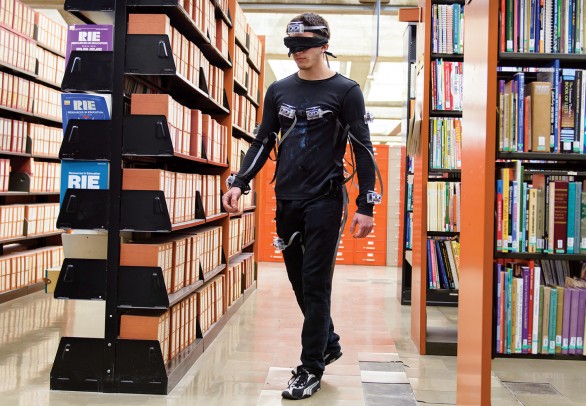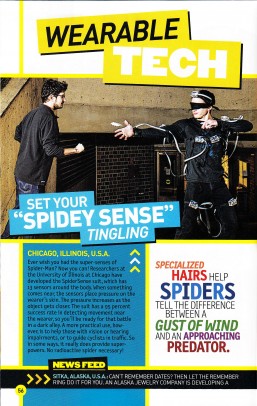EVL’s SpiderSense suit grabs National Geographic’s attention

The SpiderSense suit, created in UIC’s Electronic Visualization Lab, lets the user sense obstacles without seeing them. Photo: Lance Long
Brightening the eyes of kids and superhero fans alike, the SpiderSense suit created in UIC’s Electronic Visualization Lab is highlighted in a National Geographic Kids book.
The suit, which allows users to sense obstacles without seeing them, was featured as “Wearable Tech” in National Geographic’s Weird But True! Ripped from the Headlines Summer 2014 edition.
SpiderSense has seven sensor modules placed on the body: two on the wrists, two on the chest and one each on the back, shoulders and head. The sensors use echolocation — which bats have to navigate in the dark — and apply pressure when something is nearby.
The collaborative project began as an open-ended assignment to enhance the human experience using ambient technologies.
“The professors basically said, you guys can do whatever you want, as long as it’s something great,” said Victor Mateevitsi, doctoral candidate in computer science who helped develop SpiderSense. Mateevitsi and collaborators Brad Haggadone and Brian Kunzer had a prototype ready in three months.
Mateevitsi was one of the Crain’s Chicago Business “Twenty in their 20s” in May. Over the past two years, SpiderSense has been featured in Forbes, Gizmag, Discovery Channel Canada, New York Daily News and, more recently, the Adler Planetarium’s After Dark series.
More than 700 people lined up at the Adler Planetarium to see Mateevitsi and his team present a demo of the invention that gives people the powers of their childhood superheroes. “I didn’t even have time to drink water,” he said. “That’s how crazy it was.”
But Mateevitsi’s work goes far beyond the scope of Spider-Man.
“SpiderSense is sort of a leaf of the research tree,” he said. He continues to develop models and designs that improve the quality of human life, even if it means stepping out of the superhero world and into the world of medicine.
In a current project, Mateevitsi is working with UIC’s pathology department to build a digital microscope and wall for physicians all over the world to use collaboratively.

